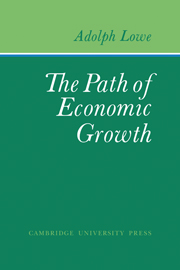Book contents
- Frontmatter
- Contents
- Preface
- Acknowledgments
- PART I The Basic Model
- 1 Introduction: Scope and Method
- 2 Patterns of Economic Growth
- 3 A Schema of Industrial Production
- 4 The Circulation of Fixed Capital
- 5 The Circulation of Working Capital
- 6 The Stationary Process in Operation: Structure Analysis
- 7 The Stationary Process in Operation: Force Analysis
- 8 Transition to Dynamic Equilibrium
- 9 Dynamic Equilibrium: Structure Analysis
- 10 Dynamic Equilibrium: Force Analysis
- PART II Changes in the Rate of Change
- PART III Changes in the Rate of Change
- PART IV Changes in the Rate of Change
- Appendix: An Alternative Presentation of Lowe's Basic Model
- Glossary of Recurring Symbols
- Name Index
- Subject Index
10 - Dynamic Equilibrium: Force Analysis
Published online by Cambridge University Press: 07 October 2011
- Frontmatter
- Contents
- Preface
- Acknowledgments
- PART I The Basic Model
- 1 Introduction: Scope and Method
- 2 Patterns of Economic Growth
- 3 A Schema of Industrial Production
- 4 The Circulation of Fixed Capital
- 5 The Circulation of Working Capital
- 6 The Stationary Process in Operation: Structure Analysis
- 7 The Stationary Process in Operation: Force Analysis
- 8 Transition to Dynamic Equilibrium
- 9 Dynamic Equilibrium: Structure Analysis
- 10 Dynamic Equilibrium: Force Analysis
- PART II Changes in the Rate of Change
- PART III Changes in the Rate of Change
- PART IV Changes in the Rate of Change
- Appendix: An Alternative Presentation of Lowe's Basic Model
- Glossary of Recurring Symbols
- Name Index
- Subject Index
Summary
On investigating the motor forces that sustain stationary equilibrium, we came up with a simple solution to the problem. In a collectivist system, we saw that the suitable behavior patterns are implied in the prescriptions of the Plan. On the other hand, the motivations that are to elicit such behavior on the part of the executants lie outside the realm of economics in the region of political-administrative control. In a free market system, on the other hand, the proper guide to stabilizing behavior appears to be an action directive aiming at maximizing pecuniary receipts and minimizing pecuniary expenditures, combined with zero elasticity of both quantity and price expectations.
When the stability of dynamic equilibrium is at stake, we can, so far as collectivism is concerned, only restate what was said about the stationary case. In a free market order, on the other hand, we find a significant change of required behavior, a change already apparent when we were discussing the transition from stationary to dynamic equilibrium. This change is ultimately grounded in a difference in quantity expectations. Whereas under stationary conditions the goal of adjustment is the recovery of the initial position of quantities and prices, steady growth, although compatible with unvarying prices, requires a steady increase in all quantities, such as inputs and outputs, employment, savings, and investments.
- Type
- Chapter
- Information
- The Path of Economic Growth , pp. 95 - 100Publisher: Cambridge University PressPrint publication year: 1976
- 1
- Cited by



